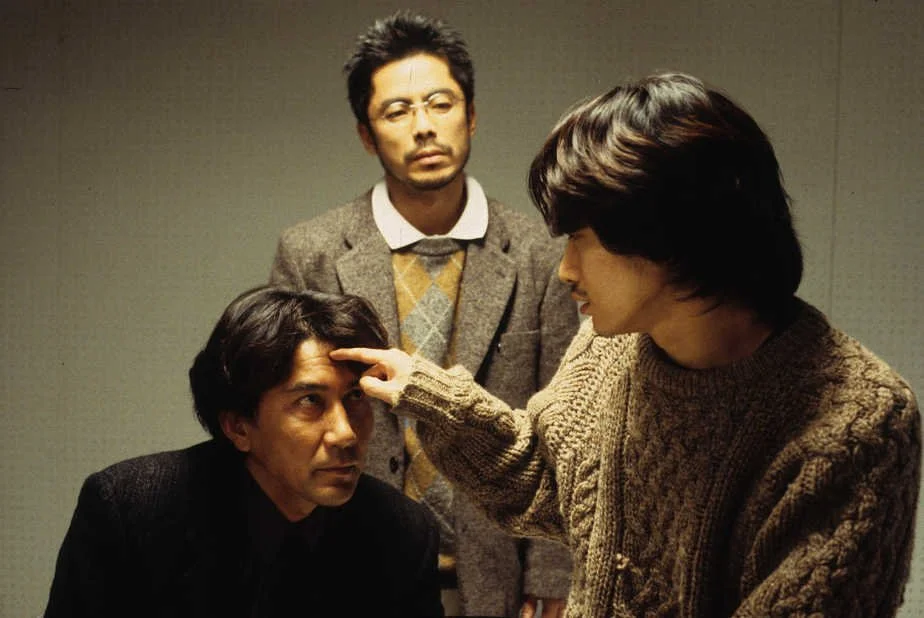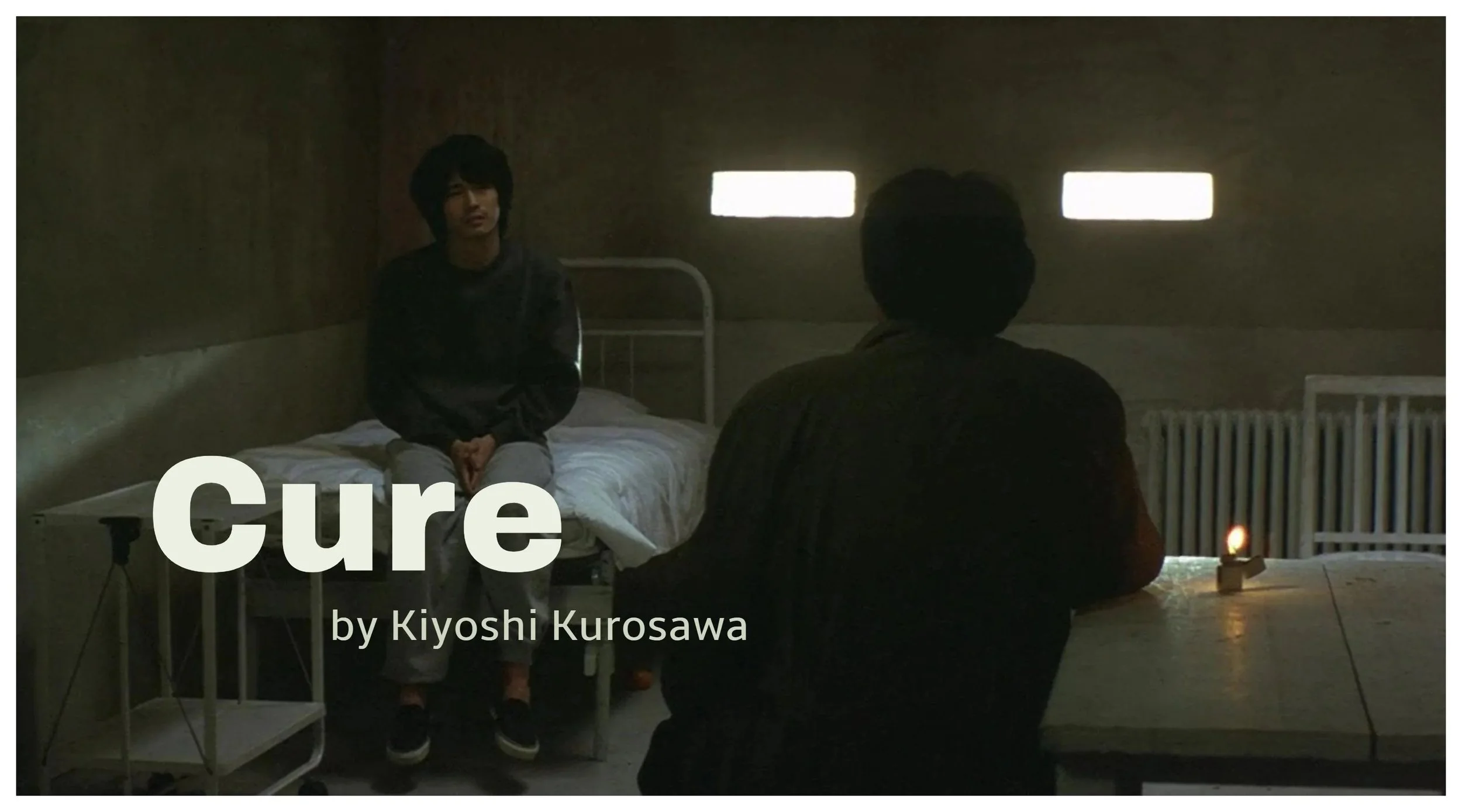Kiyoshi Kurosawa’s Cure
Cure (1997), directed by Kiyoshi Kurosawa
Since October is upon all of us, and it is duly acknowledged as the spooky month of every Gregorian calendar year, I decided to inaugurate it by watching a Japanese horror film on my Criterion Channel subscription. The film in question is called Cure and directed by Kiyoshi Kurosawa who doesn’t happen to be related to Akira Kurosawa in any way. While I don’t take well to horror films, I do have a penchant for Asian psychological thrillers that border on horror. Cure, from the extremely short description on Criterion Channel, looked very promising. It is a psychological thriller with elements of horror and deals with multiple murders. Did I like the film? Yes, but also no. Where would I place this film in my spectrum of disappointment and enjoyment? Somewhere in the middle. Why? I will tell you so.
The film opens with a scene of a young and beautiful woman reading the story of Bluebeard in a very spacious clinic that possibly doubles as an airy and bright laboratory. The title of the book has already set the theme of deviance. Quickly, we discover that she suffers from severe amnesia and is undergoing treatment. We learn that she is the wife of the protagonist who is a detective for a living. We soon see that the relationship of this couple is strained because of her illness despite her being a good homemaker who cleans and cooks and keeps the house running while her husband is away at work. In my understanding, it is Kurosawa’s oblique attempt at reflecting how society too looks perfectly functional and orderly while the collective malaise is hidden away so carefully that it is utterly invisibilized. Eventually, we see this trope repeated multiple times at an individual level each time a murder is “provoked”.
The seaside scenes leading up to the very first murder are perhaps the most beautiful shots the film has to offer, and that led to calibrating my expectations to a higher baseline. The long shots and the close-ups taken by Tokushô Kikumura are fantastic in terms of creating a sense of isolation and building trepidation as the camera looks over the shoulder while the victim and the instigator converse. Despite those masterful long shots, the mid-shots are nothing out of the ordinary, possibly establishing that society seemingly looks mundane—or perhaps mid-shots are not Kikumura’s strength. However, his deployment of chiaroscuro is commendable. He uses it sparingly, just enough to visually layer and even symbolize the intentions of his characters, especially the villain’s, as well as the effect of amnesia on them.
When Mamiya—the anti-hero—of the film pretends to be or really is an amnesiac and acts out his amnesia-induced behavior, his face is illuminated and his features are all discernable. He looks lost and pure with nothing remotely sinister about his intentions. The decision to cast Masato Hagiwara as Mamiya is well-served. Hagiwara’s soft and unassuming features work well to disguise the villain’s unethically curious mind and the horrors of his realizations are subtly underplayed. As he embarks to plant the seed of hypnosis into the minds of his victims, his face is cast in shadow while the face of his victim is illuminated, almost as though the latter is the sacrificial lamb with the spotlight on them. In a sense, this chiaroscuro becomes a visual representation of solipsism. That nothing in the world is truly real except the experiences of oneself. Facts and objective reality cease to exist and the suppressed id takes precedence. It is here where the mid shots work wonderfully when the camera is stationary and filming the murder of a policeman in broad daylight in the most dispassionate and matter-of-factly way. This camera handling positions the audience as voyeuristic and apathetic which, segues into the trope of society being deeply ill from within.
Naming the villain after a camera company is also an interesting decision, especially because the villain’s modus operandi is largely based on observation. He can be likened to the eye of the camera as well as the photographer. He chooses a suitable object/victim, carefully frames it with hypnotic instructions, and finally transmutes it into the subject/perpetrator of his grisly experiments. The sound design is avant-garde yet exceptional for it utilizes a disturbing drone of industrial white noise. This not only lends an atmospheric quality to the film but also reinforces a sense of verisimilitude despite being a non-diegetic soundscape and breaks the fourth wall by tricking the audience into believing that they are very much a part of this series of murder investigations. The mise-en-scène and narration until this point show great promise as we are immersed in an atmospheric psychological thriller.
Mamiya, of course, has a foil. The detective, played by Kōji Yakusho, who goes by the name Takabe, is the film’s protagonist. He is perhaps too literal and obvious a foil for Mamiya as he represents his love for order (we see how he eats his meals with meticulousness), tenacious loyalty towards his amnesiac wife who—he later admits—is a burden to him, and his persistence for justice which highlights his morally upright nature. He is also the only character who is immune to Mamiya’s hypnosis because of his unabashedly honest tirade which doubles as healthy psychological resistance in a climactic confrontation with Mamiya, as we finally witness the true depth of his character. This immunity that Takabe possesses arises from his self-acceptance that does not allow any insecurity to creep into his mind, unlike the other less fortunate victims. In a classical sense, Mamiya has finally met his match and found an unlikely intellectual companion. Takabe is an individual whom he can call his equal despite them being the antithesis of each other. The film is reminiscent of the anime series Monster where a very similar villain and hero populate the episodes.
Despite these two characters being well-defined, I do think that they were severely underutilized. The murders incited by Mamiya were repetitive and did little to add to the development and progression of the storyline. Unfortunately, this was a major section of the film. Mamiya’s lines were cyclical since he was suffering from amnesia and that took away a lot of the character’s potential. To make up for this, Takabe’s investigation of Mamiya’s rented apartment is when viewers get a horrific glimpse of his mind through the books, notes, the old phonograph playing cryptic broken sentences, and the mummified monkey tied to a pole in the bathroom. Fumie, who is Takabe’s wife, disappointingly amounts to a manic pixie dream girl whose only purpose in the film is to add layers of pathos and admiration to Takabe’s character. The opening scene of her reading Bluebeard in the clinic loses purpose and becomes increasingly devoid of any meaning as the film progresses.
Moreover, Sakuma, the psychologist who is Takabe’s friend, is created purely to serve as a vehicle of exposition. His comment about Mamiya being a missionary is cryptic, and yet, had he survived, we may have been given access to what he truly meant by his biblical remark. Perhaps it is an allusion to how he sees Mamiya as a messiah who is delivering humanity from the evils and sins it is entrenched in. Perhaps, this could be further taken as a Christian metacommentary of how the devil can enthrall man in the form of an angel or God. That is how the title “Cure” becomes an allusion to Mamiya’s twisted attempt to free society from the shackles of insecurity and Takabe’s endeavor to “cure” the sickness called Mamiya that is quite literally hollowing out society by removing him from society. This film takes a meditative turn that underpins themes of human deviance and psychology.
By this time, the film has unfolded in such a way that my judgment of it is largely dependent on the way the ending plays out. Unfortunately, the ending is rather abrupt with Takabe losing the last vestiges of his patience and killing Mamiya very abruptly when the latter is just about to open up. There is a possibility that it was done to preserve the mystery that shrouded Mamiya’s character, but I am led to believe that perhaps a suitable explanation of Mamiya’s intentions and character wasn’t realized. However, it does feel realistic enough in the sense that something utterly evil must be eliminated without the need to understand it for the sakes of one’s self-preservation and a society that rampantly feeds on and breeds insecurity. If the film had ended here, I would have been still somewhat satisfied. What really left a bad aftertaste for me was how the very last scene of Takabe telling the waitress that he is done with his dinner and thanking her and then witnessing the latter pull out a knife and about to commit yet another murder ruined the aesthetic and narrative integrity of the film by being badly shot and confusingly open-ended.
At first, I thought that perhaps it is Mamiya who had orchestrated this by anticipating his death by the hands of Takabe. That he had hypnotized her to kill Takabe with the intention of not only getting back at him but also posthumously winning the war of wits and determination. But after pondering on this narrative far too long and being increasingly agitated by the sheer maladroitness of it forced me to come up with a theory that this hypnosis that Mamiya had learned from the German physician Mesmer from the 18th century and was subjecting his victims to, is actually a kind of virus that seeks out a host to survive and transfer from one body to the other. Mamiya may have been a good host for the hypnosis-inducing virus but he still suffered from amnesia like his victims, which, in the end, made him unsuitable. Perhaps, through Mamiya, the virus was trying to migrate to a better host and Mamiya’s victims were all potential hosts.
Mamiya and the virus both recognize the resilience Takabe demonstrates. We are led to believe that Takabe truly is the saviour who kills off Mamiya. But if we were to go back to the scene where the former investigates the latter’s home and plays the gramophone in a bid to gather clues, we realize that it is this moment when the virus successfully enters Takabe. This confirms two things: that Mamiya was not strong enough to transfer the virus to Takabe, thus making a less-than-ideal host, and that Takabe is a better host than Mamiya. Takabe killing Mamiya without hesitation is his definite break from his moral scruples.
The second confirmation exclusively rests on the final scene, where Takabe admits his wife in an asylum instead of taking her for a vacation and interacting with the waitress in the restaurant. He does not need a lighter or a glass of water to hypnotize his victim, unlike Mamiya who had to rely on an external object. Takabe is not only self-sufficient with his hypnosis but also undetectable. His memory is intact, and he behaves like an upstanding citizen while hypnotizing his victims. In the end, there is no “cure”. This is what pushes the psychological thriller into the genre of horror and saves the film for me.
Despite the script’s psychological fecundity, Cure did not deliver to my expectations as it left much to be desired and decided to comfortably lodge itself as a middling film in my spectrum of good to great cinema for the reasons that I have just discussed. However, it did have its highlights and moments in terms of cinematography and mise-en-scène when it came to creating an atmospheric thriller peppered with elements of horror and alienation as the characters of Mamiya and Takabe somewhat successfully but laboriously carried the film to the end.
Cure (1997), directed by Kiyoshi Kurosawa

